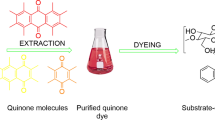Abstract
Eosin, a xanthene dye capable of the photodynamic generation of singlet oxygen (1O2), was shown to promote injury to leaf tissue of Pisum sativum L. in the presence of visible light. Chloroplasts appeared particularly sensitive to this action, displaying a rapid inactivation of photosynthesis. Investigation of chloroplast disruption involved analysis of pigment loss, ribulose 1,5-bisphosphate carboxylase (EC 4.1.1.39) activity, NADPH-glyceraldehyde-3-phosphate dehydrogenase (EC 1.2.1.13) activity, photosynthetic electron transport and ultrastructural examination. The initial loss of photosynthetic activity was associated with damage to the thylakoid membranes. Early stages of damage were accompanied by the production of ethane.
Similar content being viewed by others
Abbreviations
- GPD:
-
NADPH-glyceraldehyde-3-phosphate dehydrogenase
- RuBPCase:
-
Ribulose 1,5-bisphosphate carboxylase
- 1O2 :
-
singlet oxygen
References
Amagasa, J. (1981) Dye binding and photodynamic action. Photochem. Photobiol. 33, 947–955
Arnon, D.I. (1949) Copper enzymes in isolated chloroplasts. Polyphenol oxidase in Beta vulgaris. Plant Physiol. 24, 1–15
Bhagwat, A.S., McFadden, B.A. (1983) Pyridoxal phosphate as a probe in the active site of ribulose bisphosphate carboxylase/oxygenase. Arch. Biochem. Biophys. 223, 610–617
Codd, G.A. (1981) Photoinhibition of photosynthesis and photoinactivation of ribulose bisphosphate carboxylase in algae and cyanobacteria. In: Plants and the daylight spectrum, pp. 315–337, Smith, H., ed. Academic Press, London New York
Daub, M.E. (1982) Cercosporin, a photosensitizing toxin from Cercospora species. Phytopathology 72, 370–374
Davies, B. (1976) Carotenoids. In: Chemistry and biochemistry of plant pigments, vol. 2, pp. 38–165, Goodwin, T.W., ed. Academic Press, London New York
Delieu, T., Walker, D.A. (1981) Polarographic measurement of photosynthetic oxygen evolution by leaf discs. New Phytol. 89, 165–178
Dobrowolski, D.C., Foote, C.S. (1983) Cercosporin, a singlet oxygen generator. Angew. Chem. Int. Ed. Engl. 22, 720–721
Dodge, A.D. (1983) Toxic oxygen species and herbicide action. In: Human welfare and the environment, pp. 59–66, Miyamoto, J., ed. IUPAC Pesticide Chemistry, Pergamon Press, Oxford
Dumelin, E.E., Tappel, A.L. (1977) Hydrocarbon gases produced during in vitro peroxidation of polyunsaturated fatty acids and decomposition of preformed hydroperoxides. Lipids 12, 895–900
Elstner, E.F. (1982) Oxygen activation and oxygen toxicity. Annu. Rev. Plant Physiol. 33, 73–96
Feierabend, J., Winkelhusener, T., Kemmerich, P., Schulz, U. (1982) Mechanism of bleaching in leaves treated with chlorosis-inducing herbicides. Z. Naturforsch. C 37, 898–907
Foote, C.S. (1976) Photosensitized oxidation and singlet oxygen: consequences in biological systems. In: Free radicals in biology, vol 2, pp. 85–133, Pryor, W.A., ed. Academic Press, New York London
Foote, C.S. (1982) Light, oxygen, and toxicity. In: The pathology of oxygen, pp. 21–44, Autor, A.P., ed. Academic Press New York London
Foote, C.S., Wexler, S. (1964) Singlet oxygen. A probable intermediate in photosensitized autooxidations. J. Am. Chem. Soc. 86, 3880–3881
Gandin, E., Lion, Y., Van de Vorst, A. (1983) Quantum yield of singlet oxygen production by xanthene derivatives. Photochem. Photobiol. 37, 271–278
Gandin, E., Piette, J., Lion, Y. (1982) Purification of halogenated fluorescein derivatives by gel chromatography. J. Chromatogr. 249, 393–398
Halliwell, B. (1981) Chloroplast metabolism. Clarendon Press, Oxford
Halliwell, B., Gutteridge, J.M.C. (1984) Oxygen toxicity, oxygen radicals, transition metals and disease. Biochem. J. 219, 1–14
Heitz, J.R. (1982) Xanthene dyes as pesticides. In: Insecticide mode of action, pp. 429–457, Coats, J.R., ed. Academic Press, New York London
Ito, T. (1978) Cellular and subcellular mechanisms of photodynamic action: the 1O2 hypothesis as a driving force in recent research. Photochem. Photobiol. 28, 493–508
Knox, J.P., Dodge, A.D. (1984) Photodynamic damage to plant leaf tissue by rose bengal. Plant Sci. Lett 37, 3–7
Knox, J.P., Dodge, A.D. (1985a) Isolation and activity of the photodynamic pigment hypericin. Plant Cell Environ 8, 19–25
Knox, J.P., Dodge, A.D. (1985b) The photodynamic action of eosin, a singlet oxygen generator. The inhibition of photosynthetic electron transport. Planta 164, 30–34
Krinsky, N.I. (1979) Carotenoid protection against oxidation. Pure Appl. Chem. 51, 649–660
Latzko, E., Gibbs, M. (1969) Enzyme activites of the carbon reduction cycle in some photosynthetic organisms. Plant Physiol. 44, 295–300
Lilley, R. McC., Walker, D.A. (1974) An improved spectrophotometric assay for ribulose bisphosphate carboxylase. Biochim. Biophys. Acta 358, 226–229
Pallet, K., Dodge, A.D. (1980) Studies into the action of some photosynthetic inhibitor herbicides. J. Exp. Bot. 31, 1051–1060
Percival, M.P., Dodge, A.D. (1983) Photodynamic effects of rose bengal on senescent flax cotyledons. J. Exp. Bot. 34, 47–54
Rabinowitch, H.D., Fridovich, I. (1983) Superoxide radicals, Superoxide dismutases and oxygen toxicity in plants. Photochem. Photobiol. 37, 679–690
Reynolds, E.S. (1963) The use of lead citrate at high pH as an electron opaque stain in electron microscopy. J. Cell Biol. 17, 208–213
Riely, C.A., Cohen, G., Lieberman, M. (1974) Ethane evolution: a new index of lipid peroxidation. Science 183, 208–210
Robinson, J.R. (1983) Photodynamic insecticides: a review of studies on photosensitizing dyes as insect control agents, their practical application hazards and residues. Residue Rev. 88, 69–100
Spikes, J.D. (1977) Photosensitization. In: The science of biology, pp. 87–112, Smith, K.C., ed. Plenum Press, New York
Towers, G.H.N. (1980) Photosensitizers from plants and their photodynamic action. Prog. Phytochem. 6, 183–202
Wise, R.R., McWilliam, J.R., Naylor, A.W. (1983) A comparative study of low-temperature induced ultrastructural alterations of three species with differing chilling sensitivities. Plant Cell Environ. 6, 525–535
Author information
Authors and Affiliations
Rights and permissions
About this article
Cite this article
Knox, J.P., Dodge, A.D. The photodynamic action of eosin, a singlet-oxygen generator. Planta 164, 22–29 (1985). https://doi.org/10.1007/BF00391021
Received:
Accepted:
Issue Date:
DOI: https://doi.org/10.1007/BF00391021




